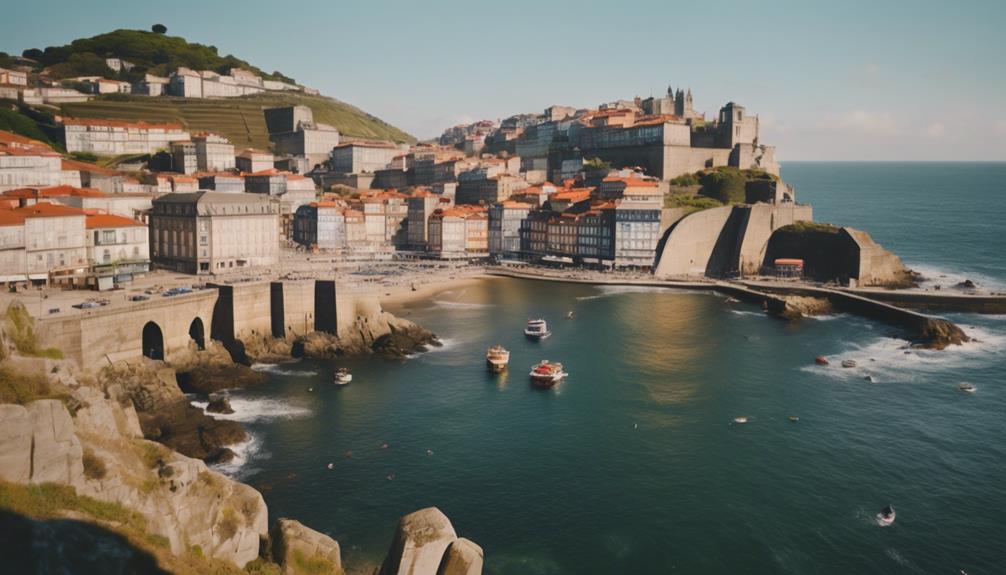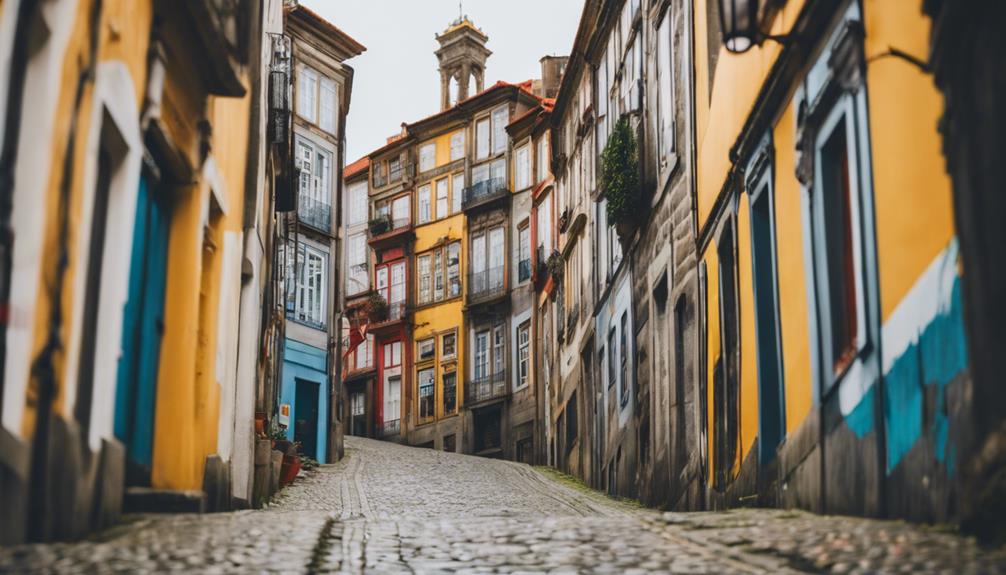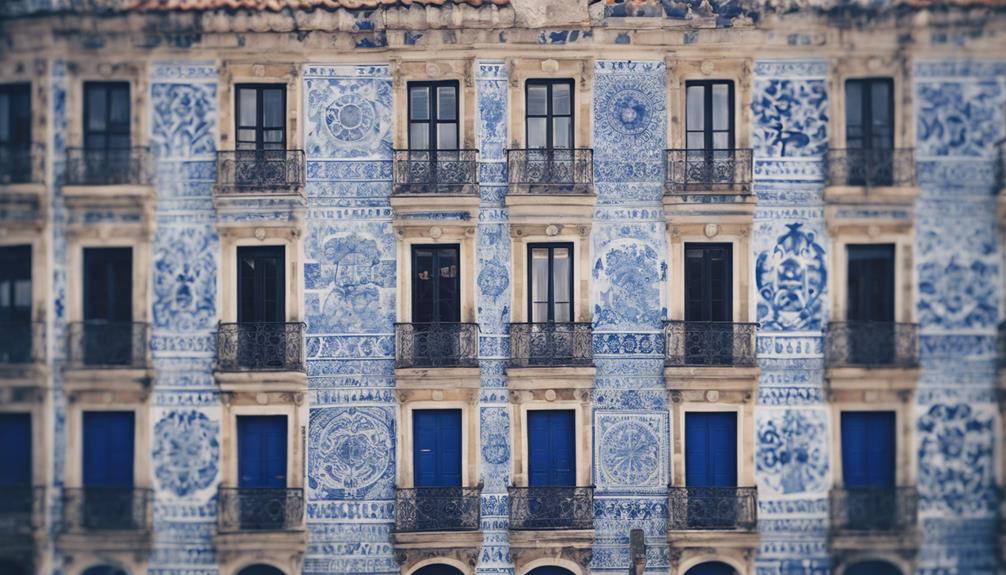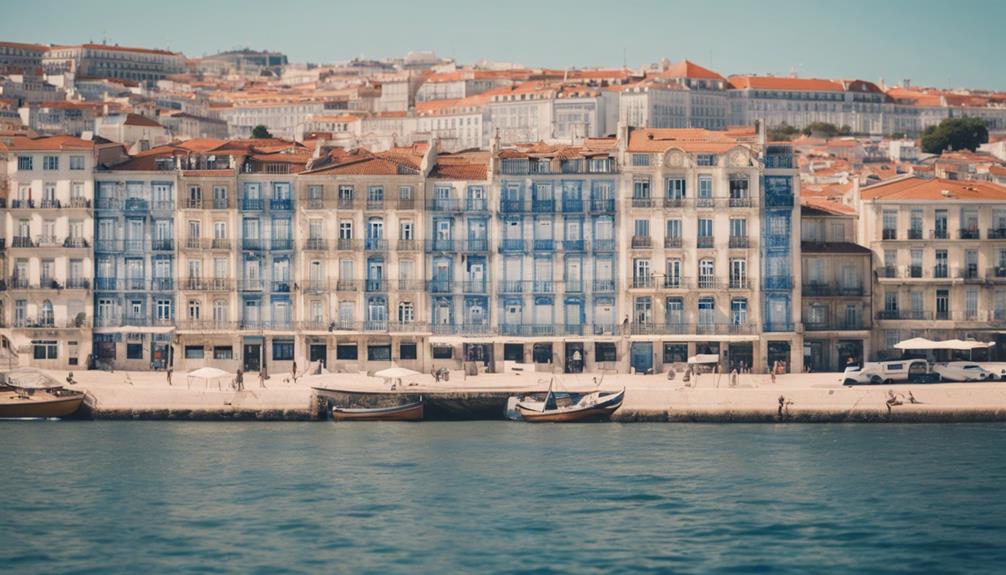Portugal
Taste the Wine and Seaside Delights of Porto
Immerse yourself in the world of Port wine and seaside delights in Porto, where culinary adventures await.

Explore the best of Porto with a blend of wine tastings and seaside delights. Immerse yourself in Port wine cellars like Sandeman and Ferreira. Discover the aging secrets of White, Ruby, and Tawny Ports. Take in the breathtaking views along the Douro River. Enjoy seaside dining and fresh seafood at Matosinhos and Foz do Douro beaches. Experience the charm where nature meets culinary delight. Ready to uncover more about these flavorful experiences?
Key Takeaways
- Enjoy immersive Port wine tastings at renowned cellars in Porto.
- Indulge in seaside delights at Matosinhos and Foz do Douro beaches.
- Explore the coastal beauty where the Douro River meets the Atlantic Ocean.
- Savor fresh seafood at waterfront restaurants along Porto's coast.
- Experience a perfect blend of nature, culinary delights, and water adventures by the sea.
Explore Porto's Port Wine Cellars
Discover the charm of Porto's Port wine cellars through immersive guided tours and tastings at renowned establishments like Sandeman and Calem. These tours offer a fascinating insight into the history and production of Port wine, allowing you to explore the unique aging processes and the flavors of white, Ruby, and Tawny Port wines.
Lasting around 1.5 hours, the guided tours provide a thorough exploration into the characteristics of different Port varieties. The interactive museums within cellars like Calem further enhance the tasting experience by delving into the rich heritage of Port production.
After the tasting session, you have the option to purchase your favorite Port wines, enabling you to savor a piece of Porto's wine culture in the comfort of your own home. Immerse yourself in the world of Port wine in Porto, where every sip tells a story of tradition and craftsmanship.
Indulge in Port Wine Tastings

When you indulge in Port wine tastings in Porto, you'll have the opportunity to sample a range of Port wine varieties. Experience the unique flavors of white, Ruby, and Tawny Port wines while learning about their history and production process.
Enjoy knowledgeable guides sharing insights during cellar tours, enhancing your tasting experience.
Wine Tasting Experiences
Immerse yourself in the rich world of Port wine by exploring the diverse Port wine cellars in Porto for guided tastings and tours.
Porto boasts a variety of renowned cellars like Sandeman, Calem, and Ferreira, offering visitors the chance to dive into the tasting experiences and learn about the intricate production process of Port wine.
These tastings provide insights into different Port styles such as Tawny, Ruby, and White Ports, allowing guests to appreciate the unique characteristics of each type.
During cellar tours in Porto, participants can discover the rich history behind Port wine and witness firsthand the craftsmanship involved in its making.
Typically lasting around 1.5 hours, these tasting experiences may also include interactive museum exhibits, enhancing the educational aspect of the visit.
Additionally, guests have the opportunity to purchase their favorite Port wines directly from the cellars, ensuring a memorable and personalized experience in the heart of Porto's wine culture.
Port Wine Varieties
Explore the diverse array of Port wine varieties available in Porto through indulgent tasting experiences that showcase the distinct flavors and characteristics of white, Ruby, and Tawny Ports. When indulging in Port wine tastings in Porto, you'll encounter a variety of options that cater to different palates. Tawny Port stands out for its deep Oak flavor, making it a favorite among Port wine enthusiasts visiting Porto. These tastings typically last around 1.5 hours, allowing you ample time to savor and learn about the different types of Port available. Some Port wine cellars, such as Calem, go beyond tastings by offering interactive museums that enhance the overall wine tasting experience. After the tasting, you can purchase your favorite Port wines to take a piece of Porto's rich wine culture home with you.
| Port Wine Variety | Flavor Profile | Popular Choice? |
|---|---|---|
| White Port | Fresh and Fruity | No |
| Ruby Port | Rich and Full-Bodied | Yes |
| Tawny Port | Deep Oak Flavor | Yes |
Wander Along Douro River

As you wander along the Douro River in Porto, you'll be greeted by scenic riverside promenades that offer stunning views of the iconic Ponte Dom Luis Bridge.
Exploring the historic Ribeira District, with its colorful buildings and traditional Rabelo boats, provides a glimpse into the rich cultural tapestry of Porto.
Don't miss the chance to stroll along the riverfront, where you can soak in the charm of this picturesque setting and enjoy the leisurely ambiance of outdoor cafes.
Scenic Riverside Promenades
Stroll along the picturesque riverside promenades of the Douro River in Porto, where colorful buildings and charming cafes create a delightful backdrop for your leisurely walks.
The scenic promenades offer stunning riverside views, with the iconic Dom Luis I Bridge and traditional Rabelo boats adding to the charm.
These riverside walks are perfect for romantic strolls, sunset watching, and capturing memorable photos of Porto's beauty.
The Ribeira district, a UNESCO World Heritage site, lines the Douro River, showcasing historic architecture and a vibrant atmosphere filled with street performers and vendors.
From the promenades, you can easily access Porto's famous wine cellars, historic sites, and trendy riverside restaurants, providing a complete cultural and culinary experience.
Whether you seek a peaceful riverside retreat or a bustling cultural hub, the riverside promenades of Porto cater to all preferences, inviting you to immerse yourself in the city's rich heritage and picturesque surroundings.
Explore Historic Ribeira District
Upon wandering along the Douro River in Porto, you'll be immersed in the historic Ribeira district's narrow cobblestone streets and charming riverside cafes. As you explore this UNESCO World Heritage site, take in the picturesque views of colorful buildings, traditional boats, and the iconic Ponte Dom Luis I Bridge that span the river.
The heart of Porto pulsates within the Ribeira district, offering a blend of historic architecture, vibrant culture, and stunning riverside landscapes.
- Experience the local artisan shops, street performers, and outdoor dining options that bring the Ribeira district to life.
- Indulge in delicious food at the riverside cafes while soaking in the maritime heritage of Porto.
- Discover why the Ribeira district is a top-rated destination on Tripadvisor, with one member praising it as the perfect starting point for exploring the city's wine and seaside delights.
Admire Ponte Dom Luis Bridge

You can't miss admiring the iconic Ponte Dom Luis Bridge when visiting Porto. Designed by Theophile Seyrig and completed in 1886, this double-deck metal arch bridge is a symbol of the city's charm.
Connecting Porto to Vila Nova de Gaia over the Douro River, it offers breathtaking panoramic views of the historic Ribeira district and the scenic waterfront. The upper deck is dedicated to pedestrians, allowing for leisurely strolls while taking in the picturesque surroundings. On the lower deck, vehicles and the metro traverse back and forth, adding to the bustling atmosphere of the area.
The architectural beauty of Ponte Dom Luis Bridge makes it a favorite spot for capturing stunning photos and enjoying the serene ambiance. Whether you're admiring the sunset hues reflecting on the river or simply marveling at the intricate design of the bridge, this iconic landmark is a must-see during your exploration of Porto.
Enjoy Seaside Dining

Indulging in seaside dining in Porto offers a delightful experience of savoring fresh seafood dishes while enjoying panoramic ocean views. The coastal touch adds a special charm to the dining ambiance, making it a memorable culinary experience.
When dining by the sea in Porto, you can:
- Sample a Variety of Seafood Dishes: From grilled sardines to octopus salad and seafood rice, the seaside restaurants in Porto offer a diverse range of fresh seafood options for you to enjoy.
- Try Local Specialties: Don't miss out on trying local delicacies like bacalhau (salted codfish) or caldeirada (fish stew) to get a true taste of traditional Portuguese cuisine right by the ocean.
- Relax in a Picturesque Setting: Many seaside eateries in Porto provide outdoor seating where you can relax, enjoy the sea breeze, and take in the breathtaking views of the Atlantic while savoring your meal.
Experience Porto's Coastal Beauty

Discover the enchanting coastal beauty of Porto, where the Atlantic Ocean and the Douro River converge to create a picturesque setting for visitors to enjoy.
Explore Porto's scenic beaches like Matosinhos and Foz do Douro, offering a perfect escape for a relaxing seaside experience. Indulge in the culinary delights of Porto's coastal area, known for its fresh seafood restaurants that provide a delightful dining experience by the sea.
Take a leisurely stroll along the seaside promenade to soak in the invigorating sea breeze and panoramic views of the coastline.
The coastal region of Porto isn't only a feast for the eyes but also a haven for water sports enthusiasts. Enjoy opportunities for surfing, sailing, and other beach activities in this vibrant coastal setting.
Immerse yourself in the coastal charm of Porto, where nature's beauty meets delectable cuisine and exciting water adventures for a truly unforgettable experience by the sea.
Frequently Asked Questions
What Is the Best Port Winery to Visit in Porto?
The best Port winery to visit in Porto is Sandeman. Known for its rich history, iconic branding, and excellent guided tours, Sandeman offers informative wine cellar tours showcasing the Port production process and a variety of tastings, including their renowned Port wines.
Visitors can explore Sandeman's cellars in Vila Nova de Gaia, gaining insights into the region's winemaking traditions and heritage. The interactive museum at Sandeman provides an immersive experience highlighting the brand's legacy and the art of Port wine production.
Sandeman is a top choice for wine enthusiasts seeking a memorable and educational Port winery visit in Porto.
What Is the Signature Dish in Porto?
The signature dish in Porto is the Francesinha, a hearty sandwich packed with cured ham, linguica sausage, steak, and melted cheese, topped with a spicy tomato and beer sauce. Locals and visitors love its rich flavors and often enjoy it with a side of fries.
This iconic dish reflects Porto's culinary passion and can be found in traditional restaurants across the city. Don't miss the chance to savor this indulgent treat during your visit to Porto!
What Is the National Dish of Porto?
The national dish of Porto is Francesinha, a hearty sandwich made with layers of bread, ham, sausage, steak, and covered in melted cheese and a spicy tomato sauce. It's often served with a side of fries and is considered a staple comfort food in Porto.
This iconic dish is a must-try for visitors looking to experience the rich flavors of Porto's culinary scene. Many restaurants in Porto offer their unique twists on Francesinha, providing endless variations to explore.
What Wine Is Porto Famous For?
Porto is famous for its sweet and fortified Port wine, a unique style produced in the Douro Valley. The wine's sweetness comes from grape spirit added during fermentation.
It boasts rich, complex flavors with hints of dark fruits, nuts, and spices. Port wine tours and tastings in the city's historic cellars offer a delightful experience to savor this renowned drink.
Conclusion
So, why not pack your bags and head to Porto to experience the perfect blend of wine and seaside delights?
Unwind with a glass of port wine in the charming cellars, take in the breathtaking views along the Douro River, and savor delicious seafood by the coast.
Porto offers a unique combination of flavors and scenery that will leave you feeling like you've discovered a hidden gem in Portugal's coastal beauty.
Don't miss out on this unforgettable experience!
Portugal
Portugal's Historic Cities and Coastal Delights
Prepare for a captivating journey through Portugal's historic cities and coastal delights, where past meets present in a mesmerizing blend of culture and beauty.

Explore Portugal's historic cities and coastal delights for a fascinating journey through the past intertwined with stunning seaside beauty. Wander through bidos, known for colorful houses and the iconic Porta da Vila. Discover Aveiro's cultural heritage on canal boats and indulge in seafood delights. Admire Pinho's Azulejo tiles, reflecting intricate craftsmanship and local life. Unwind on Tavira's sandy beaches, rich in Moorish influence. Stroll Porto's vibrant streets with azulejo-clad buildings and bustling nightlife. Immerse in Lisbon's art, culture, and green spaces for a serene escape. Venture further to uncover Lisbon's culinary scene, a fusion of tradition and innovation.
Key Takeaways
- Vibrant historic cities like bidos, Aveiro, Pinho, and Tavira offer cultural heritage and traditional charm.
- Coastal delights include sandy beaches, seafood cuisine, and outdoor escapes for relaxation and rejuvenation.
- Culinary experiences feature traditional Portuguese dishes, alfresco dining in Porto, and vibrant street food culture in Lisbon.
- Art, culture, and architecture abound in Lisbon with azulejo tiles, museums, parks, and historic venues.
- Coastal promenade walks provide scenic beauty, outdoor activities, and tranquil retreats along Portugal's coast.
Explore Bidos: a Walled Village Gem
When exploring Portugal, you mustn't miss out on the charming walled village gem of Óbidos. This picturesque Portuguese town is renowned for its colorful houses adorned with flower-filled trellises, creating a vibrant and inviting atmosphere.
As you wander through the cobblestone streets, you'll encounter the iconic Porta da Vila entrance, beautifully painted to welcome visitors into the historic village.
One of the delights not to be missed in Óbidos is trying the local delicacy, ginjinha, a cherry liqueur typically served in an edible chocolate cup. This sweet treat adds to the unique experience of immersing yourself in the traditional Portuguese culture that the village exudes.
Moreover, Óbidos hosts the lively Medieval Fair, an annual event that transports you back in time with its vibrant costumes, music, and performances. This festival showcases the village's rich heritage and offers a glimpse into its medieval past, making it a must-visit destination for history enthusiasts and cultural explorers alike.
Discover Aveiro's Canal Boats

Discover the colorful canal boats of Aveiro, known as moliceiros, which offer leisurely tours along the city's picturesque canals. These charming boats, originally used for harvesting seaweed, now serve as a delightful way to explore Aveiro's waterways and soak in its unique charm.
Here are some key points to enrich your experience:
- Cultural Heritage: The intricate designs adorning the moliceiros reflect Aveiro's rich maritime history and cultural significance, providing insight into the city's past.
- Architectural Marvels: As you glide along the canals, admire the stunning Art Nouveau architecture lining the waterfront, adding a touch of elegance to your journey.
- Seafood Delights: After your boat ride, indulge in delicious seafood dishes like bacalhau, a traditional salted cod recipe, at local eateries, savoring the flavors of the sea.
- Coastal Paradise: Extend your exploration beyond the canals to discover Aveiro's nearby sandy beaches in Costa Nova and Barra, offering a perfect blend of cultural exploration and seaside relaxation.
Immerse yourself in Aveiro's maritime charm, from its colorful boats to its delectable cuisine, for a truly memorable experience.
Immerse in Pinho's Azulejo Tiles

Immerse yourself in Pinho's Azulejo Tiles, a traditional Portuguese art form that intricately decorates the town's historic railway station, showcasing local scenes in enchanting blue and white designs. These azulejo tiles aren't just mere decorations; they're a reflection of the town's rich cultural heritage and artistic craftsmanship. Dating back to the early 20th century, the azulejo tiles in Pinho have stood the test of time, adding a unique charm to the town's architecture.
As you wander through the streets of Pinho, take a moment to appreciate the intricate details of these tiles that depict scenes from local life. Each tile tells a story, offering a glimpse into the history and traditions of this quaint town. The blue and white designs, typical of Portuguese azulejos, create a sense of harmony and tranquility, inviting you to explore further and uncover the beauty of this traditional art form.
Exploring Pinho's azulejo tiles isn't just a visual delight; it's a journey through time, where the past meets the present in a stunning display of craftsmanship and creativity.
Relax on Tavira's Sandy Beaches

When it comes to relaxing on Tavira's sandy beaches, you'll find yourself surrounded by beachside bliss. The coastal charm of Tavira is evident in the stunning Praia da Ilha de Tavira, where you can soak up the sun and enjoy the tranquil atmosphere.
From leisurely sunbathing to exploring historical sites nearby, Tavira offers the perfect blend of relaxation and cultural immersion.
Beachside Bliss in Tavira
Indulge in ultimate relaxation on Tavira's sandy beaches, where the gentle waves and soft sands create a blissful seaside escape.
Here are some key aspects to enhance your beachside bliss experience in Tavira:
- Praia da Ilha de Tavira: Accessible by a brief boat ride, this picturesque beach offers a serene retreat away from the hustle and bustle of the city.
- Moorish Architecture: The influence of Moorish architecture can be seen in Tavira's historic castle, providing a unique backdrop to your beach day.
- Laid-back Atmosphere: Tavira's charm lies in its relaxed ambiance, perfect for unwinding and soaking up the sun without any rush.
- Local Delights: After a day of beach relaxation, head to Praça da República to enjoy alfresco dining and immerse yourself in the local culture and cuisine.
In Tavira, you'll find the perfect blend of coastal beauty, cultural richness, and tranquility, making it an ideal destination for a rejuvenating getaway.
Coastal Charm of Tavira
Discover the coastal charm of Tavira as you unwind on its sandy beaches, basking in the serene atmosphere and historical allure. Tavira, a quaint coastal city in Portugal, is renowned for its beautiful churches, inviting visitors to explore its historical past while enjoying a laid-back coastal atmosphere.
One of the highlights of Tavira is Praia da Ilha de Tavira, a stunning beach accessible by boat, perfect for sunbathing and relaxation. The city's castle, reflecting Moorish architecture, stands as a proof of its rich history, offering visitors a glimpse into the past.
For those seeking a taste of local culture, Praça da República, a charming square in Tavira, provides an ideal setting for alfresco dining and immersing oneself in the town's ambiance. Tavira's picturesque scenery and welcoming vibe make it a perfect destination for leisurely exploration and embracing the coastal charm that defines this enchanting city.
Wander Porto's Vibrant Streets

As you wander through Porto's vibrant streets, you'll encounter a tapestry of colorful tiles, stunning bridges, and a bustling nightlife that adds to the city's charm.
Take a stroll through the historic Cais da Ribeira district to immerse yourself in Porto's rich cultural heritage and unique character.
Don't miss the chance to admire the intricate azulejo tiles that adorn prominent buildings, showcasing the fine Portuguese artistry that defines the city's architectural landscape.
Porto's Cultural Charm
Immerse yourself in Porto's cultural allure by strolling through its vibrant streets adorned with colorful tiles and historic architecture. The city's lively atmosphere and rich heritage offer a unique experience for visitors seeking to explore its hidden gems.
Here are four reasons why Porto's cultural allure is truly enchanting:
- Azulejo Tiles: Admire the iconic azulejo tiles that decorate the facades of buildings, showcasing intricate patterns and vibrant colors that reflect Portugal's artistic history.
- Cais da Ribeira District: Wander through the historic Cais da Ribeira district along the Douro River, where charming alleyways and picturesque views create a postcard-worthy setting.
- Terraced Gardens: Enjoy peaceful picnics in Porto's terraced gardens, offering a serene escape from the bustling city while providing stunning panoramic vistas of the Douro River.
- Cultural Heritage: Explore Porto's rich history and cultural legacy by visiting museums, art galleries, and historic sites that highlight the city's significance in Portugal's past and present.
Exploring Coastal Treasures
Wander through Porto's vibrant streets to discover a treasure trove of coastal delights waiting to be explored. As one of Portugal's famed coastal cities, Porto boasts a blend of historic charm and modern allure.
The city's terraced gardens offer scenic spots for relaxation, providing panoramic views of the city and the river. Iconic azulejo tiles adorn many buildings, showcasing Portugal's rich artistic heritage and adding to the city's unique aesthetic.
In addition to its cultural attractions, Porto is known for its vibrant nightlife scene, adding an exciting dimension to exploring the coastal treasures. The Cais da Ribeira district is a popular area for wandering, where visitors can immerse themselves in the city's history and ambiance.
Whether strolling along the riverfront or admiring the colorful architecture, Porto's coastal delights are sure to captivate any traveler seeking a mix of relaxation and exploration.
Enjoy Alfresco Dining in Porto

Experience the vibrant alfresco dining scene in Porto, which boasts numerous outdoor cafes and restaurants along the picturesque riverfront. When dining al fresco in this charming city, you can savor traditional Portuguese dishes like bacalhau and francesinha while taking in the stunning views of the Douro River and iconic bridges such as Dom Luís I Bridge.
Here are four reasons why alfresco dining in Porto is a must:
- Culinary Delights: Indulge in a variety of traditional Portuguese dishes, from fresh seafood to hearty meat dishes, all while enjoying the pleasant outdoor atmosphere.
- Scenic Views: Feast your eyes on the breathtaking vistas of the Douro River and the historic cityscape as you dine under the open sky.
- Lively Atmosphere: Immerse yourself in the lively ambiance of Porto's terraced gardens and bustling squares, adding an extra layer of enjoyment to your dining experience.
- Local Flavors: Sample the local wines and spirits that perfectly complement the flavors of Porto's alfresco dining options, creating a truly authentic culinary adventure.
Experience Lisbon's Art and Culture

Discover Lisbon's vibrant art and culture scene through a diverse range of museums, parks, and culinary experiences. Start your artistic journey at the Calouste Gulbenkian Museum, where you can admire a vast collection of art spanning different periods and styles.
After immersing yourself in the museum's treasures, take a leisurely stroll through the Chiado neighborhood, known for its vibrant street life and unique boutiques that showcase local artists' work.
For a taste of Lisbon's theatrical scene, attend a performance at the National Theater of São Carlos, a historic venue that hosts a variety of cultural events throughout the year.
To unwind and connect with nature, explore the lush Edward VII Park, a peaceful oasis in the heart of the city where you can relax and recharge amidst beautiful greenery.
End your day with a culinary adventure at A Cevicheria, where you can indulge in creative ceviche dishes that combine traditional flavors with innovative twists, reflecting Lisbon's dynamic food scene.
Lisbon's art and culture offerings provide a rich tapestry of experiences for every visitor to enjoy.
Visit Lisbon's Historic Azulejo Tiles

Immerse yourself in Lisbon's rich cultural tapestry by exploring the historic Azulejo tiles adorning the city's architectural gems. These intricate blue and white designs, dating back to the 15th century, are a testament to Portugal's craftsmanship and cultural heritage.
As you wander through Lisbon, take a moment to appreciate the following:
- Historical Significance: Azulejos can be found on churches, palaces, and even train stations, each telling a unique story of Portugal's past.
- Symbolism: These tiles are more than just decorations; they represent historical events, religious scenes, and intricate geometric patterns, reflecting the country's rich heritage.
- Arabic Influence: The word 'azulejo' originates from Arabic, highlighting the Moorish artistry that influenced Portuguese tile-making.
- Artistic Tradition: The art of creating azulejo tiles has been passed down through generations, preserving Portugal's artistic traditions for centuries.
Take a moment to admire these beautiful tiles that not only decorate Lisbon's buildings but also serve as a reflection of Portugal's craftsmanship and cultural heritage.
Explore Lisbon's Green Spaces

Discover Lisbon's hidden garden treasures, such as the charming Jardim da Estrela with its 19th-century pavilion.
Take a leisurely stroll through Edward VII Park or immerse yourself in the exotic flora at Lisbon Botanical Garden.
Don't miss the modern allure of Parque das Nações, offering stunning river views and serene promenades amidst the city's bustling energy.
Lisbon's Park Gems
Lisbon's green spaces offer an invigorating escape from the bustling city life, inviting visitors to unwind and connect with nature. Explore these park gems:
- Eduardo VII Park: Enjoy leisurely strolls and picnics while taking in panoramic views of the city.
- Jardim da Estrela: Find tranquility in this oasis with a charming lake, exotic plants, and a playground for families.
- Tapada das Necessidades: Immerse yourself in a botanical garden, enchanting ruins, and a peaceful atmosphere perfect for nature lovers and history enthusiasts.
- Parque das Nações: Discover modern architecture, waterfront promenades, and cultural venues like the Lisbon Oceanarium.
Each park offers a unique experience, from historic charm to modern amenities, catering to a variety of interests.
Whether you seek a peaceful retreat surrounded by nature or a cultural exploration within the city, Lisbon's park gems provide a perfect blend of relaxation and recreation for visitors of all ages.
Coastal Promenade Walks
Take leisurely coastal promenade walks along the Tagus River in Lisbon, offering invigorating views of the city and the water. These green spaces provide a peaceful retreat from the urban hustle, inviting you to immerse yourself in nature while staying within the city limits.
Whether you prefer a relaxing stroll, a jog, or simply basking in the scenic beauty, the coastal promenades offer a perfect setting for outdoor activities. Explore lush parks like Eduardo VII Park or the riverside paths near Belém, where you can enjoy the tranquility and greenery that Lisbon has to offer.
Along these paths, you'll find outdoor cafes, benches, and recreational areas, enhancing your experience with opportunities for relaxation and enjoyment. These stunning views and leisurely strolls along the Tagus River create a harmonious blend of nature and urban life, making them an ideal choice for those seeking an invigorating escape in Lisbon's green spaces.
Hidden Garden Treasures
Nestled within Lisbon are enchanting garden sanctuaries waiting to be uncovered, each offering a serene escape from the city's hustle and bustle. Here are four green spaces in Lisbon to explore:
- Edward VII Park: This expansive park is perfect for leisurely walks and picnics, boasting lush greenery and spectacular views of the city.
- Lisbon Botanical Garden: A botanical gem in the heart of Lisbon, this peaceful oasis showcases a diverse collection of plants and provides a revitalizing retreat from urban life.
- Jardim da Estrela: A hidden gem for relaxation, this charming park features a picturesque lake, lovely gardens, and a playground, making it an ideal spot for families and nature lovers.
- Parque das Nações: Originally built for the 1998 World Expo, this modern waterfront park offers a blend of gardens, art installations, and leisure activities, creating a vibrant and contemporary green space for visitors to enjoy.
Don't miss out on exploring these hidden garden treasures in Lisbon for a rejuvenating retreat amidst the city's vibrant atmosphere.
Indulge in Lisbon's Culinary Scene

With a vibrant mix of traditional Portuguese flavors and innovative culinary creations, exploring Lisbon's food scene promises a delightful journey for your taste buds. The city is renowned for its seafood delicacies such as bacalhau and grilled sardines, showcasing the richness of Portugal's coastal offerings. Don't miss out on trying the famous pastel de nata, a delectable Portuguese custard tart available at local bakeries. For a gourmet experience, visit Time Out Market Lisboa, where renowned chefs present a variety of dishes to tantalize your palate. Additionally, immerse yourself in Lisbon's vibrant street food culture, sampling treats like bifana, a savory pork sandwich, and pastéis de bacalhau, crispy codfish cakes.
| Traditional Portuguese Cuisine | Vibrant Street Food Culture |
|---|---|
| Seafood Delicacies | Time Out Market |
Embark on a culinary adventure in Lisbon, where tradition meets innovation, and every bite tells a story of Portugal's rich gastronomic heritage.
Frequently Asked Questions
What Is the Best Seaside Town in Portugal?
Cascais stands out as the best seaside town in Portugal. Its blend of charming beaches, historic sites, and vibrant atmosphere attracts visitors seeking relaxation and exploration.
From water sports to seafood dining, Cascais offers diverse activities for beach lovers and adventure seekers. Its proximity to Lisbon makes it an ideal day trip or beach getaway destination, drawing both locals and tourists with its picturesque coastline and lively marina.
Where Is the Most Beautiful City in Portugal?
When considering the most beautiful city in Portugal, Lisbon stands out like a shining gem among the rest.
With its blend of historic charm, vibrant street life, and stunning viewpoints, Lisbon offers a unique and enchanting experience for visitors.
From the historic Alfama district to the iconic Belem Tower, Lisbon's beauty is akin to a masterpiece painting that comes to life before your eyes.
What Is the Most Moorish Town in Portugal?
Tavira is often hailed as the most Moorish town in Portugal, showcasing well-preserved Moorish influences in architecture and culture. Its 11th-century castle, built by the Moors, stands as a proof of its rich history.
The town's whitewashed buildings, narrow streets, and traditional tiled roofs all reflect the prevalent Moorish architectural style. Visitors can explore historic churches, gardens, and ancient walls, all highlighting Tavira's strong Moorish identity.
Which Region in Portugal Is the Most Beautiful?
The region in Portugal that's the most beautiful is subjective, as beauty can be interpreted differently by each individual. Some may find the stunning coastline of the Algarve with its golden sandy beaches and dramatic sea cliffs to be the epitome of beauty.
Others might be captivated by the picturesque vineyards and terraced slopes of the Douro Valley producing exquisite port wines. Ultimately, the most beautiful region in Portugal is a matter of personal preference.
Conclusion
Portugal's historic cities and coastal delights offer a wealth of experiences for travelers. Did you know that Portugal is home to over 3,000 hours of sunshine a year, making it one of the sunniest countries in Europe?
From exploring charming villages to relaxing on sandy beaches, there's something for everyone to enjoy in this beautiful country. So pack your bags and get ready to uncover the treasures that Portugal has to offer!
Portugal
Lisbon's Tile Facades and Seaside Setting
Heralded by intricate azulejo facades and stunning seaside vistas, Lisbon's charm awaits those seeking a cultural and coastal fusion.

Immerse yourself in Lisbon's charm through its iconic azulejo tile facades and scenic seaside views. These glazed ceramic tiles, originating from the 13th century, adorn the city with intricate blue, yellow, and white designs. Reflecting Moorish, Renaissance, and Baroque influences, they uniquely blend artistry and history. Strolling through districts like Alfama and Belém, you'll encounter a rich tapestry of vibrant tile facades narrating Lisbon's vibrant past and cultural heritage. Coastal treasures along the waterfront depict maritime scenes, adding to the city's allure. Discover more about Lisbon's tile traditions and seaside allure by exploring further.
Key Takeaways
- Lisbon's tile facades blend Moorish influences and vibrant colors, reflecting the city's artistic heritage.
- Seaside setting influences coastal tile designs, showcasing maritime themes and cultural influences.
- Tiles along the waterfront depict ships, sea creatures, and navigational instruments, honoring Lisbon's seafaring past.
- Coastal tile treasures create mesmerizing mosaic effects with polished tiles, enhancing the city's charm.
- Modern interpretations of tile designs combine tradition with innovation, reflecting Lisbon's contemporary aesthetic appeal.
Azulejo: A Portuguese Art Form
Azulejo, a mesmerizing Portuguese art form, was introduced by Arabs in the 13th century and has since become a prominent feature in Lisbon's architectural landscape. These glazed ceramic tiles boast intricate designs, often showcasing blue, yellow, and white palettes that depict historical, religious, and everyday scenes.
Azulejos aren't only prevalent in Portugal but also widely seen adorning buildings, sidewalks, and even Lisbon Metro stations. The term 'azulejos' originates from the Arabic word for polished stone, emphasizing the influence of Arab culture on Portuguese tile art.
Inspired by the Alhambra in Spain, azulejos in Portugal have evolved to include a diverse range of colors and styles, transforming Lisbon into a vibrant and colorful masterpiece. The intricate patterns and vibrant hues of azulejos contribute significantly to the unique charm and visual appeal of Lisbon's architectural aesthetics, making them a must-see feature for visitors exploring the city.
Historical Significance of Lisbon's Tiles

Lisbon's tiles hold a significant place in the city's history and culture. They showcase a blend of traditional tile-making traditions, reflecting Portugal's artistic heritage.
Through intricate designs and colorful patterns, these tiles narrate stories of Lisbon's past, serving as a visual language that connects the city's cultural tapestry.
Tile-Making Traditions
The historical significance of tile-making traditions in Lisbon dates back to the Moorish influence in the 13th century. Ceramic tiles, often adorned with intricate geometric shapes, especially in blue and white, have been a hallmark of Lisbon's architectural landscape for centuries.
These tiles, influenced by Moorish design, evolved over time to incorporate elements from the Renaissance, Baroque, and modernist eras, creating a unique blend of styles. The use of blue, yellow, and white hues in Lisbon's tiles reflects the city's rich artistic heritage and cultural identity.
The tradition of tile-making in Lisbon extends beyond mere decoration; it serves as a medium for storytelling, depicting historical events, religious themes, and scenes from everyday life on building exteriors. The vibrant and colorful tile facades in Lisbon attract visitors from around the world, offering a visual journey through the city's past and present artistic expressions.
Cultural Storytelling Through Tiles
Immerse yourself in Lisbon's rich cultural tapestry as you explore the historical significance of its alluring tiles, each intricately designed to narrate the city's vibrant past. The tile murals adorning Lisbon's facades aren't merely decorative; they're windows into the city's soul, showcasing its diverse influences and storied past.
From intricate geometric patterns influenced by Moorish designs to elaborate Baroque and Art Nouveau styles, each tile holds a piece of history waiting to be discovered.
Every tile tells a unique story, whether depicting scenes from Portuguese history, religious events, or everyday life. The story behind each tile is a tribute to the craftsmanship and artistry that went into creating these visual masterpieces.
As you wander through Lisbon's streets, these tiles serve as more than just embellishments; they serve as a living art form that connects you to the rich tapestry of Portuguese culture and history.
Let these tiles guide you through the city's evolution, preserving its cultural identity for generations to come.
Colorful Facades of Lisbon

Lisbon's colorful facades boast vibrant tile patterns that showcase a rich historical significance and architectural diversity.
The intricate azulejos, blending Moorish, Baroque, and Art Nouveau influences, adorn the city's buildings with scenes of historical events, religious motifs, and maritime themes.
As you explore Lisbon's streets, you'll encounter a visual tapestry of diverse color palettes and patterns that define the city's unique artistic identity.
Vibrant Tile Patterns
Adorned with vibrant tile patterns, the facades of Lisbon's buildings showcase a fusion of Moorish influences and Portuguese artistic identity. The colorful tiles not only add an artistic flair but also tell a story of the city's rich history. Each intricate design reflects a mix of artistry and cultural significance, creating a unique visual experience as you wander through Lisbon's streets.
The vibrant colors and patterns on the facades are more than just decorative elements; they're a tribute to Lisbon's heritage and creativity. The intricate tile work is a blend of traditional Portuguese aesthetics and Moorish craftsmanship, capturing the essence of both cultures in a mosaic of beauty.
As you admire the colorful tile facades, you can't help but appreciate the attention to detail and the skill involved in creating these works of art. The combination of historical details and vibrant colors makes Lisbon's buildings not just structures but living pieces of art that breathe life into the city's streets.
Historical Significance
The colorful facades of Lisbon, dating back to the 16th century, intricately blend Moorish, Renaissance, and Baroque influences, embodying the city's rich historical significance.
These vibrant tile facades, with their geometric patterns and bold colors ranging from cobalt blue to sunny yellows, serve as a visual tapestry of Lisbon's past. The use of azulejos on facades not only adds to the aesthetic appeal but also reflects Portugal's former colonies through the incorporation of intricate designs and symbols.
Throughout Lisbon, these tiled facades tell a story of maritime exploration, cultural exchange, and artistic evolution. The tradition of decorating buildings with tiles not only showcases the city's architectural heritage but also highlights the practical benefits of protection and insulation that these tiles provide.
Each neighborhood in Lisbon boasts its own unique style of tile work, showcasing a blend of traditional craftsmanship and modern interpretations that seamlessly merge contemporary art with historical elements. Lisbon's colorful facades stand as a tribute to the city's enduring legacy and creative spirit.
Architectural Diversity
Explore the architectural diversity of Lisbon through its vibrant and intricate tile facades that narrate a colorful tale of artistic fusion and historical legacy.
The city's facades are a sight to behold, with a plethora of colors that reflect Lisbon's lively energy and cultural richness. Traditional azulejo tiles, characterized by their white base and floral motifs, add a unique charm to Lisbon's buildings, turning the city into a vibrant masterpiece of decorative tiles.
Modern artists in Lisbon have taken this tradition a step further by combining traditional tile styles with contemporary design elements, resulting in facades that are both unique and eye-catching. The use of geometric figures, as well as human and animal representations on Lisbon's facades, adds depth and character to the city's architectural landscape, showcasing a blend of old-world charm and modern creativity.
When wandering through Lisbon's streets, be sure to look up and admire the colorful tapestry of facades that tell a story of artistic evolution and cultural identity.
Artistry in Lisbon's Architecture

Immerse yourself in Lisbon's architectural charm, where artistry flourishes through intricate tile facades and historic narratives. The city's signature tile art, known as azulejos, can be seen adorning buildings in a striking black and white motif.
One prominent artist, Maria Keil, made significant contributions to Lisbon's architectural landscape through her innovative use of tiles in public spaces. These decorative elements not only add a visual appeal to the city but also serve as a reflection of Lisbon's rich cultural heritage and artistic innovation.
The intricate designs of the azulejos depict a wide range of subjects, from historical events to everyday life scenes, all rendered in vibrant colors that captivate the viewer's imagination. As you explore Lisbon's streets, you'll encounter these stunning tile facades that not only showcase the city's identity but also contribute to its unique artistic ambiance.
The combination of tile art and Lisbon's seaside setting creates a picturesque backdrop that seamlessly blends artistry with natural beauty, making every corner of the city a work of art waiting to be discovered.
Seaside Charm of Lisbon

Nestled along the Atlantic Ocean, Lisbon's seaside charm enchants visitors with its vibrant maritime culture and stunning views. The city's proximity to the coast not only influences its colorful tile facades but also shapes its lively atmosphere. Lisbon's coastal location provides an invigorating ocean breeze that adds to the allure of its historic neighborhoods adorned with beautiful tiles.
The combination of seaside charm and intricate tile work creates a truly unique and alluring experience for those exploring the city. The maritime culture of Lisbon is deeply ingrained in its identity, reflected in the bustling port activities and the seafood-centric cuisine that delights locals and tourists alike. The city's connection to the sea is evident in its architecture, with buildings echoing the colors of the ocean and the vibrant energy of the waterfront.
Whether you're strolling along the promenade or relaxing at a seaside cafe, Lisbon's seaside charm is sure to leave a lasting impression on you.
Exploring Lisbon's Tile Districts

Lisbon's vibrant tile districts like Alfama and Belém offer a rich tapestry of intricate and historic tile facades reflecting the city's cultural heritage. As you wander through these neighborhoods, you'll find tiles everywhere, creating a mesmerizing display of colors and patterns that tell the story of Lisbon's past and present.
Alfama, the birthplace of fado music, is a treasure trove of hidden gems where you can discover colorful tiles adorning its narrow streets and historic buildings.
Belém district, known for its major sights and museums, showcases beautiful tile work that transforms ordinary facades into exquisite pieces of art.
Lisbon's unique city palette inspires designers to incorporate Moorish touches and historical details from the city's tile facades into modern spaces, showcasing how this traditional art form continues to influence contemporary design.
Immerse yourself in the Portuguese identity as you explore these districts, where each tile carries a piece of Lisbon's history and cultural richness.
Azulejos in Everyday Life

Explore how azulejos play a significant role in everyday life across Lisbon, enriching the cityscape with their vibrant designs and historical significance. In Lisbon, you will find these ceramic tiles not only on historical buildings and churches but also in more commonplace locations like cafes, restaurants, and residential areas. Azulejos come in various styles, from traditional geometric patterns to modern interpretations, all reflecting Lisbon's cultural heritage and artistic flair. Even metro stations showcase these tiles, adding a touch of elegance to daily commutes.
To give you a better idea of the diversity of azulejos in everyday settings, here is a glimpse into their presence:
| Everyday Location | Type of Azulejo | Description |
|---|---|---|
| Residential Areas | Individual Tiles | Brightly colored motifs on white tiles create a picturesque atmosphere. |
| Cafes | Geometric Patterns | Intricate designs adorn walls, inviting you to appreciate the artistry. |
| Metro Stations | Historical Narratives | Azulejos tell stories of Lisbon's past, making your commute culturally enriching. |
Lisbon's Coastal Tile Treasures

The intricate tile facades along Lisbon's seaside showcase unique designs inspired by the city's maritime heritage and cultural influences. These coastal tile treasures can be found adorning buildings along the waterfront, adding a touch of artistic flair to the city's coastal charm.
When exploring Lisbon's coastal areas, you'll notice that tiles often depict scenes of ships, sea creatures, and navigational instruments, paying homage to the city's seafaring past. The small polished tiles used in these facades create a mesmerizing mosaic effect, reflecting the sunlight and enhancing the vibrant colors of the designs.
Whether you're strolling along the promenade or waiting for a train at a metro station, take a moment to admire the beauty of these coastal tile treasures that adorn Lisbon's architectural landscape. Each tile tells a story, blending tradition with modern aesthetics to create a visual feast for visitors and locals alike.
Contemporary Tile Designs in Lisbon

Embracing a fusion of tradition and innovation, modern tile designs in Lisbon captivate with their vibrant colors and intricate patterns. These contemporary tile designs in Lisbon blend the traditional construction material of azulejos with modern interpretations, creating a stunning visual landscape throughout the city. Artists in Lisbon infuse their unique creations with elements that reflect the vibrant culture and rich history of the region.
The modern interpretations of azulejos in Lisbon feature a mix of colors, patterns, and themes that push the boundaries of traditional tile art. Lisbon's contemporary tile facades boast a combination of geometric shapes, intricate details, and artistic flair that add a fresh and innovative touch to the city's architectural scenery.
The new tile designs not only showcase the creativity of local artists but also contribute to the city's overall aesthetic appeal, making Lisbon a must-visit destination for art and design enthusiasts.
Frequently Asked Questions
What Are the Tile Sidewalks in Lisbon?
Tile sidewalks in Lisbon, known as calçadas, are intricate mosaic designs made from limestone and basalt shards. Originating after the 1755 Lisbon earthquake, they were mandated by Dom Joao II to pave Portugal's roads.
Reflecting local heritage, designs in towns like Pinhão and Lagos feature motifs like grape-growing and fishing industries. In Sintra, star-shaped mosaics pay homage to the town's name, showcasing artistic diversity.
This mosaic sidewalk technique spread across Portugal in the mid-19th century.
Why Does Lisbon Have so Many Tiles?
Why does Lisbon have so many tiles?
Lisbon's rich history of Moorish and Manueline influence, coupled with a tradition of storytelling through azulejos, contributes to the abundance of tiles.
The practicality and durability of tiles in Portugal's warm climate and seaside location make them a popular choice.
The vibrant colors and intricate designs dating back to the 15th century enhance Lisbon's architectural charm, serving as a cultural and artistic expression of the city's identity.
What Are Two Ways That Azulejos Are Still Relevant in Modern Portugal?
In modern Portugal, azulejos remain relevant due to their adaptability to different architectural styles, providing timeless elegance to buildings.
Additionally, custom-designed azulejos are in high demand, with artisans and workshops creating unique tiles for contemporary spaces.
The blend of traditional techniques with innovative designs showcases the country's rich cultural heritage while meeting the aesthetic needs of modern design trends.
Azulejos continue to be a popular choice for both interior and exterior decoration, reflecting Portugal's artistic legacy.
What Is the Significance of the Azulejos?
The significance of azulejos lies in their portrayal of Portugal's history, culture, and artistic heritage. These traditional ceramic tiles serve as visual storytellers, capturing moments from the past and reflecting the country's identity.
Through intricate designs and vibrant colors, azulejos adorn buildings and landmarks, showcasing a unique artistic style that has evolved over centuries. Their presence not only adds beauty to Portugal's architectural landscape but also preserves and celebrates its rich cultural legacy.
Conclusion
To sum up, Lisbon's tile facades and seaside setting offer a unique blend of artistry and charm that captivate visitors from around the world.
Whether you're strolling through the colorful districts, admiring the historical significance of the azulejos, or simply enjoying the coastal views, there's no shortage of beauty to be found in Lisbon's architectural treasures.
So, next time you visit this vibrant city, be sure to take in the stunning tile work that truly sets Lisbon apart.
Portugal
Lisbon's Tiled Architecture and Seaside Setting
Immerse yourself in Lisbon's rich history and vibrant seaside culture through its iconic Azulejo tiles, a captivating fusion of art and storytelling.

Immerse yourself in Lisbon's tale through its Azulejo tiles, a fusion of Moorish and Spanish influences hand-painted with historical narratives. Reflecting the seaside, these tiles mirror ocean hues with nautical themes, connecting buildings to the sea. The tiles not only tell stories but regulate temperatures, safeguard walls, and adorn iconic locations. Preservation efforts combat challenges of humidity and pollution with ongoing restoration programs. Engage in workshops to experience Portuguese tilework firsthand, gaining cultural insights and visiting stunning sites. Discover future trends like sustainable materials and digital printing reshaping traditional designs. More awaits, revealing deeper layers of this intricate art form.
Key Takeaways
- Azulejo tiles reflect Lisbon's history and culture.
- Designs incorporate seaside elements like blues and greens.
- Connect buildings to the ocean with nautical themes.
- Preserve heritage through restoration programs.
- Blend traditional techniques with contemporary styles.
History of Lisbon's Azulejo Tiles
In Lisbon's architectural landscape, the history of Azulejo tiles unfolds as a vibrant tapestry influenced by Moorish and Spanish traditions since the 13th century. These ceramic tiles, known as azulejos, are meticulously hand-painted and glazed, often portraying historical narratives or religious motifs. They hold immense cultural significance in Portuguese architecture, adorning walls and facades with intricate designs that showcase the country's artistic heritage.
Throughout Lisbon, iconic locations such as the National Tile Museum and Sᅢᆪo Vicente de Fora Church proudly display the beauty and craftsmanship of azulejo tilework. These tiles not only serve as decorative elements but also serve to preserve Portugal's rich cultural history for generations to come.
In recent times, artists have reimagined azulejo tiles by blending traditional techniques with contemporary styles. This modern interpretation has seen the incorporation of azulejos into interior design and art installations, bridging the gap between past and present in a vibrant display of creativity.
Influence of Seaside Environment

The proximity of Lisbon's coastal location not only influences the color schemes and motifs of its tiled architecture but also infuses a sense of maritime heritage and tranquility into the intricate designs. The geometric shapes and floral motifs seen in the tiles often reflect the coastal environment, with patterns resembling waves, seashells, and fish. These elements connect the buildings to the sea, creating a harmonious blend between architecture and nature.
The use of blues, greens, and whites in the tilework mirrors the ocean's calming hues, evoking a feeling of relaxation and peace. Additionally, nautical themes such as compass roses, lighthouses, and sailors are prevalent, showcasing Portugal's deep-rooted history of seafaring. The incorporation of these maritime elements not only adds visual interest to the architecture but also serves as a reminder of Lisbon's rich connection to the sea, making the city's tiled buildings truly unique.
Artistic Significance in Architecture

Artistically significant in Lisbon's architecture, the intricate azulejo tiles showcase Portugal's rich history and culture through storytelling designs. These tiles, often forming beautiful tile murals, aren't merely decorative but also functional, regulating temperatures and safeguarding walls from wear and moisture.
You can admire the artistry of azulejo tilework in iconic locations like the São Bento Railway Station in Porto and the National Tile Museum in Lisbon. The fusion of traditional techniques with contemporary interpretations gives Lisbon's architecture a unique aesthetic appeal, blending the past with the present seamlessly.
Additionally, modern artists are breathing new life into azulejo tile-making, infusing innovative designs that reflect Portugal's artistic identity and keep the tradition continues to evolve. So, as you explore Lisbon's streets, take a moment to appreciate how these tiles narrate the tales of the country's vibrant past and artistic heritage, adding a touch of cultural richness to the city's architectural landscape.
Preservation Efforts and Challenges

Efforts to preserve Lisbon's tiled architecture involve ongoing restoration programs to maintain the historical significance of azulejo tiles.
Glazed tiles, known as azulejos, are integral to Lisbon's architectural identity, showcasing intricate designs that reflect the city's rich cultural heritage.
However, challenges arise in preserving these tiled buildings due to environmental factors such as humidity and pollution which can lead to deterioration over time.
Conservationists play a vital role in protecting and repairing damaged tiles to secure the longevity of these artistic and architectural treasures.
Various organizations and government initiatives provide essential support for the preservation of Lisbon's tiled architecture through funding and expertise.
The intricate designs and cultural significance of the tiles make preservation efforts critical in maintaining Portugal's rich artistic heritage.
Azulejo Workshops and Tours

Discover the immersive world of azulejo workshops and tours in Lisbon, where you can engage in hands-on experiences and gain insights into the rich heritage of Portuguese tilework. These workshops offer a unique opportunity to delve into the artistry and craftsmanship behind the stunning tiled architecture that adorns the city's buildings. Guided tours provide a deeper understanding of the history and cultural significance of azulejo tilework in Portugal. Skilled artisans lead participants through the intricate process of painting and glazing azulejos, sharing their expertise and techniques along the way. Participants often get the chance to visit iconic locations, showcasing some of the most breathtaking examples of tiled architecture in Lisbon.
| Azulejo Workshops | Tiled Architecture |
|---|---|
| Hands-on experiences | Delve into artistry and craft |
| Insightful guided tours | Learn about history and culture |
| Painting and glazing techniques | Visit iconic locations |
| Skilled artisans | Appreciate stunning examples |
| Cultural heritage | Immersive learning experience |
Future Trends in Tiled Architecture

With sustainability at the forefront of architectural innovation, tiled structures are embracing eco-friendly materials and modern design elements to shape the future of urban landscapes. Here are four key future trends in tiled architecture:
- Innovative Materials:
Tiles often incorporate sustainable materials like recycled glass, promoting environmentally conscious construction practices while adding a modern touch to buildings.
- Digital Design Revolution:
Advancements in digital printing technology have allowed for intricate patterns and realistic textures on tiles, enabling personalized creations that elevate tiled architecture to an art form.
- Biophilic Integration:
Increasingly, tile designs draw inspiration from nature, incorporating patterns, colors, and textures that mimic the outdoors and promote biophilic design principles within interior spaces.
- Interactive Features:
Customizable tile designs now include interactive elements such as light-up tiles and kinetic features, transforming tiled surfaces into dynamic and engaging components of modern architecture. Collaborations between artists and tile manufacturers further push boundaries, creating unique and artistic installations that redefine traditional design norms.
Frequently Asked Questions
What Are the Tiles in Lisbon Architecture?
In Lisbon's architecture, the tiles, known as azulejos, are traditional Portuguese ceramic tiles. These colorful and intricate designs can be found on buildings, churches, and metro stations.
They depict historical, religious, and artistic themes, showcasing Portugal's maritime history, cultural traditions, and natural landscapes. Beyond their aesthetic beauty, azulejos help regulate indoor temperatures and protect walls from moisture.
Lisbon's tiled architecture is a key part of its cultural heritage, reflecting its artistic identity and historical storytelling.
Why Are There so Many Tiled Streets in Lisbon?
In Lisbon, the abundance of tiled streets is a reflection of the city's rich tradition of azulejo tilework. These tiles, dating back centuries, not only serve a decorative purpose but also help regulate temperature and protect buildings from moisture.
Influenced by Moorish, Spanish, and Portuguese styles, the intricate designs of the tiles add to Lisbon's charm and cultural identity. So, when exploring Lisbon, appreciate the beauty and history behind these tiled streets.
What Is the Significance of Portuguese Tiles?
Portuguese tiles, or azulejos, hold significant cultural and architectural value. Originating in the 13th century, these hand-painted or mass-produced ceramic tiles feature intricate designs in blue and white colors. They adorn various buildings, including churches and palaces, depicting historical and religious scenes.
Beyond decoration, azulejos regulate temperature, prevent moisture damage, and reflect Portugal's artistic identity. Prominent locations like São Bento Railway Station and Pena Palace showcase the importance of azulejos in Portuguese architecture.
What Are the Tile Sidewalks in Lisbon?
In Lisbon, tile sidewalks, or 'calçadas portuguesas,' are meticulously crafted from small black and white limestone tiles.
These intricate patterns, dating back to the 19th century, feature geometric designs, waves, or floral motifs.
Skilled artisans hand-lay each tile to create durable walkways that not only add charm to the streets but also aid in water drainage and prevent slipping.
The result is a stunning mosaic underfoot that showcases Lisbon's rich cultural heritage.
Conclusion
To sum up, Lisbon's tiled architecture and seaside setting create a unique and picturesque backdrop for exploring the city. As they say, 'beauty is in the eye of the beholder,' and the stunning azulejo tiles and ocean views certainly capture the hearts of visitors and locals alike.
From the historical significance of the tiles to the artistic flair they bring to the city, Lisbon's architecture is truly a sight to behold. So next time you're in Lisbon, be sure to take a moment to admire the beautiful tiles that adorn the city's buildings.
-

 Texas2 months ago
Texas2 months agoWaco's Historic Sites and Texas Comfort Food
-

 Michigan2 months ago
Michigan2 months agoStellantis Leadership Team: Guiding Global Auto Giants
-

 Florida2 months ago
Florida2 months agoHistoric St. Augustine's Spanish Charms
-

 Alaska2 months ago
Alaska2 months agoThings to Do in Ketchikan Alaska
-

 Florida2 months ago
Florida2 months agoThings to Do in Panama City Florida
-

 Video Game2 months ago
Video Game2 months agoThings to Do in Minecraft
-

 Colombia2 months ago
Colombia2 months agoThings to Do in Cartagena
-

 Massachusetts2 months ago
Massachusetts2 months agoThings to Do in Boston With Kids



















